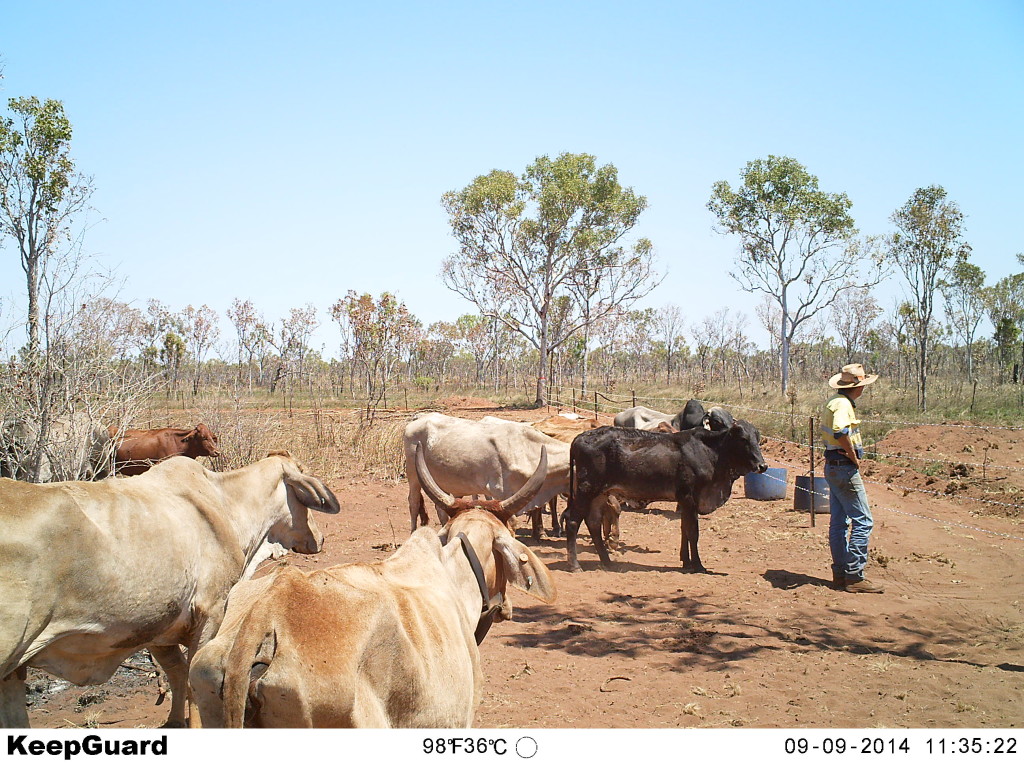Rangelands Self Herding – A Novel Approach to Livestock Management
Host: Country Downs Station
Written by Nikki Elezovich – Owner, Country Downs Station.
As we have stated in previous blogs, we are very much into what is generically called “Low Stress Stock-handling” or “Low Stress Stockmanship”. Whatever you want to call it, the biggest mistake people make is believing that it is actually low stress manipulation of the animals. As one of our mentors in this field, Jim Lyndsay, has pointed out, it is not actually ‘low stress’ handling. It is more about teaching your livestock to cope and deal with the necessary pressures that they will have to meet in their lives by being domesticated livestock.
Ultimately the term “low stress stock-handling” to me means that if you can work a yard of cattle (regardless of numbers) without getting angry, frustrated, stressed, chased up the rails etc., then you have succeeded. Low stress handling is not about being nice and gentle, it is about teaching your animals that sometimes bad stuff is gonna happen, but it won’t last forever and then they can go on their merry way again! I equate it to going to the dentist. We all detest it, but we all know that there will be an end to that feeling of dread and fear when we get out of that chair!
Once your animals have learnt this, they will always look to you for direction. That said, it is nowhere near as easy as it sounds to learn how to direct your livestock. I still fail on a regular basis when I have a yard full of cattle looking at me asking me “What is it that you want me to do?” and apparently my body language and position has told them “ALERT, ALERT, SCATTER TO THE FOUR WINDS!”, which is also why I have now decided that when you can get the chooks to do what you want using these techniques, then you have pretty much mastered it!
During 2015, we took this whole concept of ‘training’ our cattle another step further and undertook a project that had some very novel and different ways of ‘teaching’ our cattle to hang around a totally new waterhole without immediately marching out in a bee-line straight for ‘home’ as soon as you drop them off a truck. Whilst we were already interested in the concept of ‘Rangelands Self Herding’, as a result of the fires in 2014 we had to take some drastic livestock management actions in order to enable the cattle to survive the four months of no feed and no rain. We had just completed the construction of the new dams, but they were in areas of the property that were never utilised previously and also unfenced. The risk of cattle wandering off the property to look for ‘better pastures’ was very real, particularly when the first thunderstorms of the season hit us and the green pick started coming up.
The whole idea and concept of ‘Self Herding’ has come from a number of experts and scientists from around the world. However, through the help and support of Rangelands NRM, we were extremely lucky to hear and learn about this from a leading advocate, Fred Provenza, who teaches these concepts in America and comes over to Australia regularly to impart his knowledge. We also had Bruce Maynard and Dean Revell, the Australian duo who have taken these concepts and put them into practice themselves with their own successes, come over and spend days with us developing some ideas and strategies to help the transition of the cattle into different areas.
The main thing that we learnt out of the project was that, the more you can ‘control’ your livestock with positive reinforcements rather than negative impacts, the better the mental state of your cattle and the easier job you will have when the requirement to muster/trap or interact with your livestock.
So what did we do? Well, firstly we picked out what we considered to be a small group of cattle that would be representative of our whole herd. Obviously we didn’t choose the ‘wildest’ or ‘fizziest’ individuals, but more the quieter ones – those who we had confidence would ‘think’ and not ‘react’ when put into a new environment. Once that done, we separated this group and worked them for a week. During this time, we set about ‘training’ this group to respond to a range of auditory, visual, olfactory (smell) and dietary (food) cues that would condition them to respond in a positive, calm, and repetitive fashion when given the same cues at random in the future.
Every day, three times a day, I would go over to this herd and blow a whistle in the same way and promptly feed out ‘treat’ items into a number of tubs and drizzle with molasses. After two days of doing this, about 15 of the 30-odd cattle would mob me as soon as I walked into the yard – I would literally have to move out the way before I was ram-raided and then stand off to the side to blow the whistle. The point of the whistle was to associate the noise of the whistle with the delicious food items, and it worked a treat!
Now I know it sounds a bit odd, but it gets even weirder. We then made up a visual and aural signal structure to teach them to associate this structure with the treat food items as well as standard lick or supplement items, e.g. salt or phosphorous. This structure was a basic steel pole that could hang of a tree or branch or rails and had a few ‘sensory toys’ for the cattle hanging off of it. In addition, a big noisy cow bell was attached to the whole structure and a couple of CD’s (I used Kurt’s favourite country and western one!) were hung off the top of it and the whole unit was hung in the yards. I must admit when I first put it up the cattle were just staring at me as if I was bonkers. Putting it up was an arduous, noisy, and obviously entertaining event to the cattle, for as soon as I left, they were straight over to investigate. All sounds a bit odd right?
Well the theory is that when you ‘train’ this group of cattle to associate these items, e.g. whistle, hanging structure etc., they learn that when they see, hear, and smell these things then there is a delicious treat right next it. A bit like a pot of gold at the end of a rainbow. At the same time you are working these cattle in your ‘low-stress’ manner and getting their heads in a balanced and ‘thinking’ fashion, so that when we wanted to move them out to new watering points they would see these items and think “Hey, I know that, that means something delicious will be here, I am going to stay here because I feel safe and I get treats”.
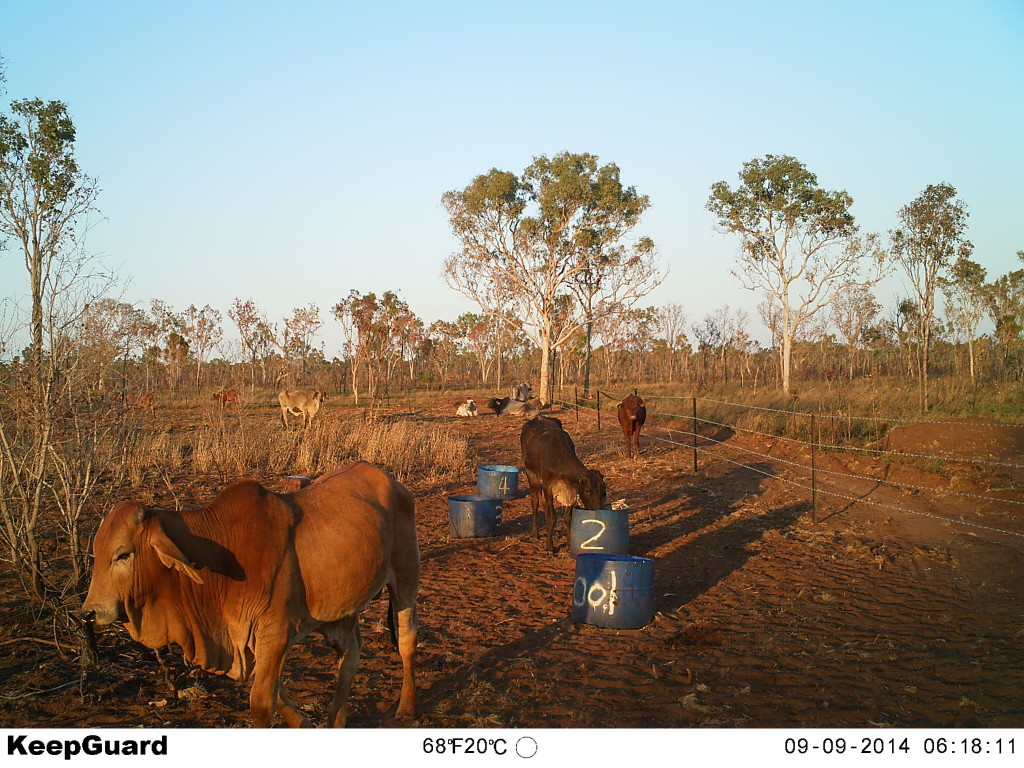
The feed tubs in the yard around a new waterhole. The bins are numbered purely for our reference only so that we knew which bins to put what food items in! These photos were taken by game cameras that were set up so that we could observe animal behaviour without the effects of human interaction . . . interestingly their behaviour didn’t much change whether we were there or not!
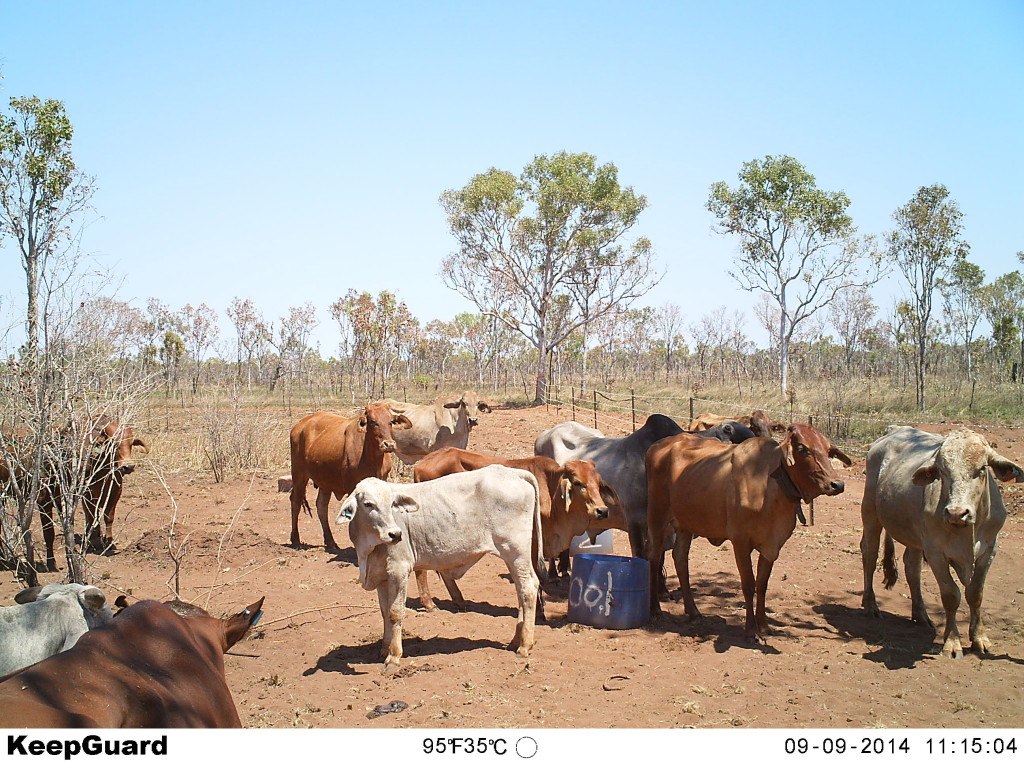
We put radio-tracking collars on two cows (see red cow on right of photo) to monitor their movements throughout the transition. What we found was that in general they hung around the water and moved out in different directions on a daily basis. Amazing what technology these days can do for you and therefore your management decisions.
Did it work? Yes! It did. We moved the cattle out to the new waterholes and continued the ‘training’ in a yard for a couple of days. A few days later, we went out there with a bale of hay, moved the tubs of treats outside the yard and with some trepidation, opened the gates and blew the whistle. What happened? Well, what we were hoping for was the bolder, calmer individuals would walk out the gateway, meander over the tubs or hay and investigate. What we didn’t want to see was a mad rush of cattle heading out the gateway and charge off into the scrub never to be seen again. What we saw was a mad rush of cattle running out the gateway and start fighting over the tubs and hay! Our calmest individuals turned into the crazy ones and the originally ‘wilder’ ones held back, had a look and then proceeded to calmly walk out of the yard and investigate the hay and tubs. A success do you think? We thought it was anyway, we drove home happy, calm, and laughing about the calm cattle that made a rabidly mad dash of about 25m!
Day of Reckoning! This was the day we moved the feed bins outside the yard and opened up the yard to let them out. Note the cow in the forefront with the other radio tracking collar. Also note the success associated with choosing calm cattle and using low stress techniques. These cattle could be considered to be ‘under pressure’ as they are in an enclosed yard and yet are not at all concerned with our presence.
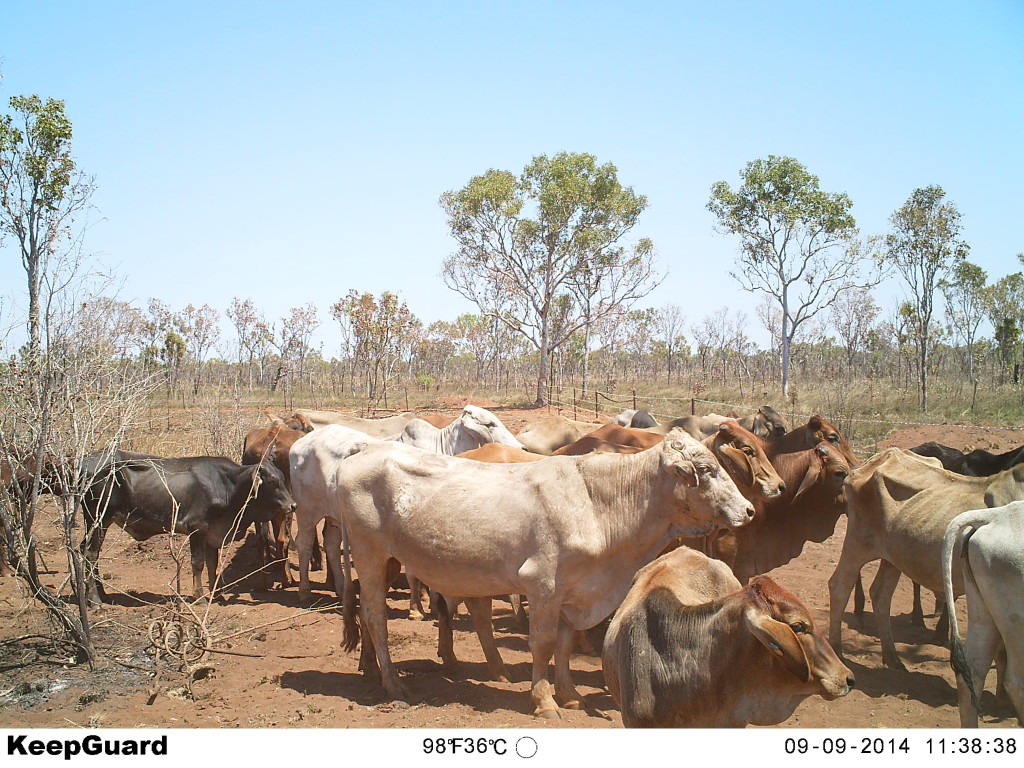
This was taken about minute before we opened up the yard. What the cattle are watching is Kurt and I unrolling a bale of hay and topping up bins of feed. Every single one is watching with a mix of excited anticipation and curiosity.
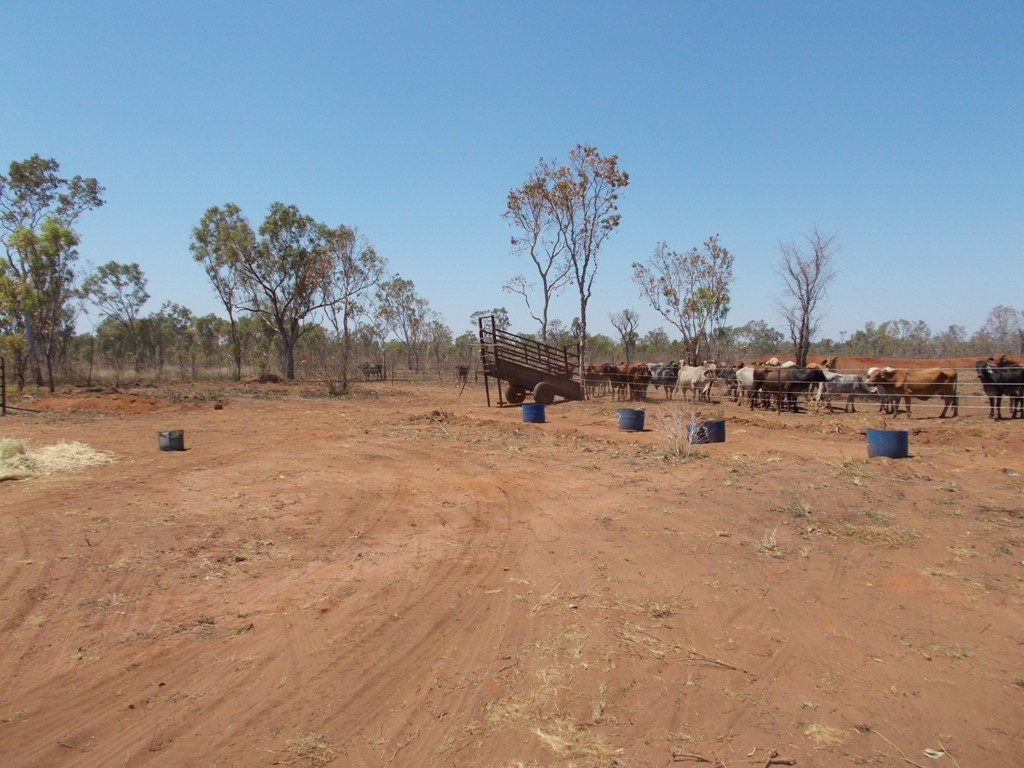
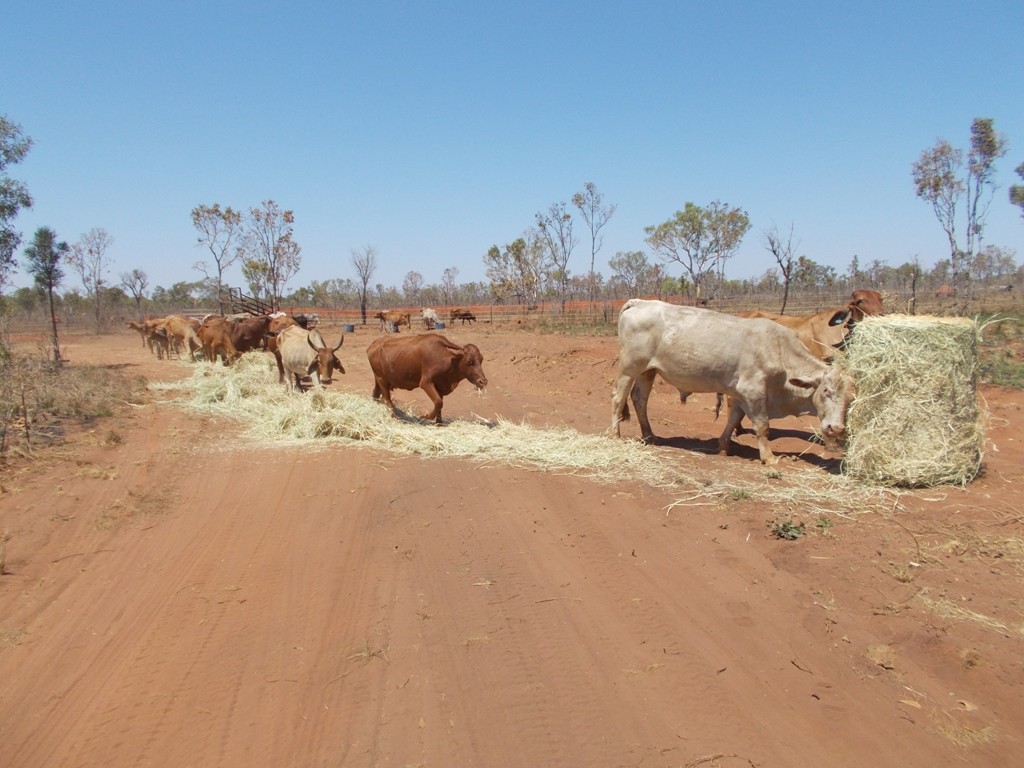
It is a wonderful thing to watch a group of cattle that you have invested a lot of time, patience, and novel strategies into, go and actually behave the way you were hoping them to. So the overall point of the Self Herding theory is that once you train your first group, they will remember it forever, as long as you keep it up on a random basis. They will also teach other individuals that behaviour, so making it a little easier for us to teach the whole herd. But most importantly, because it always a positive reinforcement that allows them to make the association, you can convince them to move to all sorts of areas that you wish them to be moving around in. Just by putting some tubs, a strange noisy hanging structure and blowing a whistle. If everything was that easy, wouldn’t life be grand!
Are we still doing this? Yes, to an extent, but now we have realised the potential of this concept to make interacting with our livestock so much easier, more efficient, cheaper and generally less stressful . . . on us that is!

